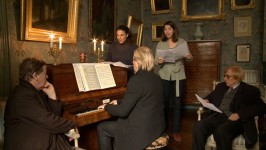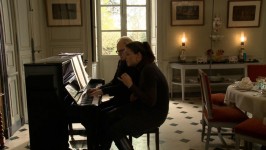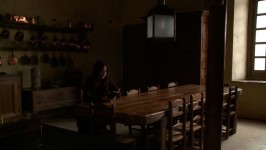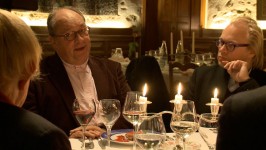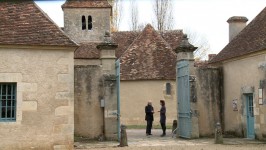Chopin at the Opera
Facts
Music Documentary, 60 min, 2010Directed by Jan Schmidt-Garre
For Chopin opera was the highest form of art – even though he never entertained the thought of writing for the stage himself. At the castle of Chopin’s beloved George Sand, in Nohant in France, three singers, a pianist and an actress meet with the most knowledgeable contemporary experts on bel canto and Chopin. They delve into Chopin’s opera experiences: his admiration for the great bel canto singer Giuditta Pasta, his friendship with Bellini and his relationship with Pauline Viardot, who, as pianist and composer, arranged Chopin’s Mazurkas for voice and piano.
Featuring:
David Adorján
Jean-Jacques Eigeldinger
Peter Feuchtwanger
Sylvain Guignard
Katerina Hebelkova
Vesselina Kasarova
Christiane Libor
Roland Pöntinen
Roland Raphael
Jörg Splett
Michael Stegemann
Cinematography: Ralph Netzer
Sound recording: Hartmut Tscharke
Editor: Gaby Kull-Neujahr
Directed by Jan Schmidt-Garre
Co-produced by ZDF/3sat, NRK, SVT, VRT, YLE and RB Film
Supported by Media+
Press
Max Nyffeler, Februar 2010
Als gelungene Dokumentation über einen musikalischen Gegenstand, der nicht so ohne weiteres darstellbar ist, erwies sich » Chopin in der Oper « von Jan Schmidt-Garre. Der Filmemacher darin untersucht die Einflüsse der italienischen Oper auf das Klavierwerk des vor 200 Jahren geborenen Komponisten. Was als trockene musikwissenschaftliche Abhandlung hätte herauskommen können, wird hier zu einem stimmungsvollen filmischen Essay, der Auge und Ohr gleichermaßen anspricht. Das ist nicht zuletzt dem reizvollen Regieeinfall zu verdanken, die kleine Schar von Diskutanten und Musikern, die der Thematik nachgehen, in das Landschloss von George Sand in Nohant einzuladen, wo Chopin acht Jahre lang komponierenderweise die Sommer verbrachte. Die romantische Atmosphäre des abgeschiedenen Ortes färbt auf die Gespräche und Musikeinlagen unverkennbar ab und verleiht ihnen Tiefe und Konzentration.
Releases
On DVD with Arthaus Musik including a bonus concert: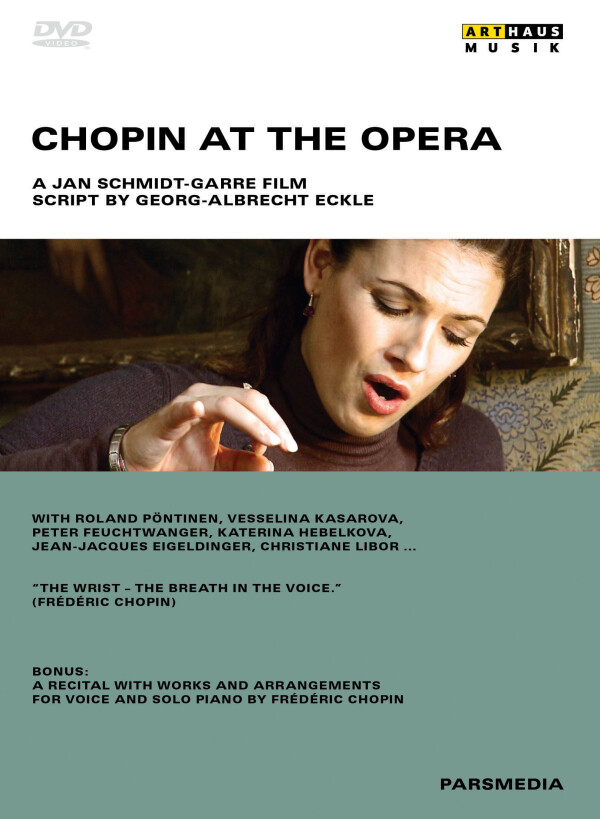
Texts
Chopin’s Students Remember
Georg-Albrecht Eckle: Flowing Form
Peter Feuchtwanger: Bel Canto on a Percussion Instrument?
Chopin’s Students Remember
In the eyes of the master, the best way to achieve naturalness in one’s playing was by frequently going to hear the Italian singers performing in Paris at that time, some of whom truly remarkable artists. He always recommended them to pianists as examples, due to their simple and generous style as well as the ease with which they used their voice, and thanks to which they were able to sustain it so remarkably.
Moritz Karasowski
When Chopin asked me about my musical studies, I answered that listening to singing had taught me more than any other thing. „You are absolutely right; music should be singing” he remarked. And under his fingers the piano virtually sang, in various ways.
Unknown Scotswoman
„You must sing if you want to play the piano,” Chopin said to Mme Rubio; and he made her take singing lessons and commit to frequent visits to the Italian Opera – things he considered absolutely necessary for a pianist.
Frederick Niecks
Chopin played me four Nocturnes that I did not yet know – what a joy! It was incredibly beautiful. In his play he entirely copies the vocal styles of the singers Rubini, Malibran, Grisi etc.; he says so himself. Yet he seeks to reproduce the particular style of each of these artists with a specifically pianistic ‘voice’, while they had and still have other means at their disposal…
Maria von Grewingk
In the course of his lessons, Chopin repeated incessantly: „You must sing with your fingers!"
Maria von Grewingk
He let the musical phrase under his hands sing with such clarity, that it turned each note into a syllable, each bar into a word, each phrase into a thought. It was a declamation without emphasis, both simple and sublime.
Carl Mikuli
As regards maintaining the tempo, Chopin was inflexible, and many would be surprised to learn that the metronome never left his piano. Even in his much discredited tempo rubato, one hand – the one with the accompanying voice – continued playing strictly in the same tempo, while the other one – the one singing the melody – liberated the truth of the musical expression from all metric constraints; be it that it creates indecisive delay, be it that it anticipates, inspired with a kind of feverish vehemence, as someone passionately heated with speech.
Carl Mikuli
Today Chopin entrusted me with another simple technique for achieving a marvelous result. I felt clearly what the sins of my playing were, but could not identify their source. In order to conform with his principle, consisting of imitating the great singers on the piano, he prised the secret of expressing breath out of the instrument. At every point where the singer is required to inhale, the pianist – if he is not a layman – must set out to lift the wrist so as to let it drop back onto the sung note with the utmost subtlety. Achieving this subtleness is the most difficult thing that I can think of. But when I achieved it, I laughed with joy, beholding the beautiful sonority, and Chopin exclaimed: „That’s it! Perfect! Thank you!"
Maria von Grewingk
Under Chopin’s fingers there was no need for the piano to envy the violin for its bow or the wind instruments for their living column of air: the notes intertwined, recreating the most accomplished melting-quality of the vocal art. The sound he was able to extract from the instrument was always very broad, especially in the cantabile.
Carl Mikuli
Even in his published works he would sometimes introduce ornaments, distinguishing every repetition by new embellishments, according to his taste at the moment.
George Alexander Osborne
Chopin used to say about this kind of ornament: „It should seem improvised, resulting from a mastery of the instrument, rather than the object of an exercise.” He himself was the inaccessible paragon in that regard: something like Field playing the piano in Paradise!
Wilhelm Lenz
Quotes from „Chopin Seen through the Eyes of his Students” by Jean-Jacques Eigeldinger, Éditions Fayard 2006, english by Barbara Eckle
Georg-Albrecht Eckle: Flowing Form
Setting out to make a film about Chopin, one is confronted with two obstacles: Firstly the stereotypical mould into which Chopin, the person and legend, has been forced over the years – an approach to be avoided. And secondly, the music that features in the film – music that has functioned as a breeding ground for listeners’ private emotions throughout the history of its reception, resulting in the development of an erroneous view of its essence.
How does one overcome these obstacles?
Firstly, by avoiding all generalities about Chopin, i.e. by specifying a subject for research that is the key to creating a flowing form of film that goes beyond the usual preconceived structures. Hence the choice of subject: Chopin and bel canto – the phenomenon of opera that lay behind his music: “Chopin at the Opera”.
Secondly, by capturing the transient nature of music, i.e. by not using pre-recorded music but rather letting it evolve during the film itself in an open-ended work process that generates a sense of suspense – and a sense of risk.
Thirdly, by foregoing diverse imagery, concentrating instead on a single meaningful location where everything comes together. Different protagonists, both musicians and scholars, gather in Nohant, the place where Chopin wrote many of his works. In many ways not much has changed since Chopin’s day, which ensures the requisite atmosphere. The film condenses a week spent by a committed group of Chopin enthusiasts who have withdrawn to this location...
These ingredients result in something guided by a rather different aesthetic: no acting, no narration and no neutral documentation. Instead the film re-evokes something past, something that once happened in that place. What remains of it? Does any scent of the past still linger? Does our revival of it help us to understand it better?
Such a flowing form of film also represents a way of thinking that brings together reflection and intuition – as in Chopin’s absolute music.
Peter Feuchtwanger: Bel Canto on a Percussion Instrument?
Pianists and piano teachers all too often hear experts say that the piano is a percussion instrument, and that it does not matter whether the key is depressed by a pencil or by a finger, whether it is a construction worker or a pianist who strikes the note, since the quality of the tone depends merely and entirely on the speed of the action. However, most of us suffer when the piano is being tuned and the tuner hammers out every note con furore. Pianists try to produce a beautiful tone without consciously thinking how quickly or how slowly the key must be depressed. The great difference between a construction worker and a sensitive pianist is, after all, contained in the capacity of imagining the sound beforehand – if this is not considered as the first priority, music making should be given up altogether.
Why is it that the pianists of the past were much more concerned with beauty of tone than so many pianists of the present day? Perhaps because we live in a noisy world, we often play in larger concert halls, which makes us believe that we have to force the tone. We also allow ourselves to indulge in ugly body movements at the piano, movements that interfere with the tone production and which would have been unthinkable a few generations ago. Above all, I think, we ought to search for the reason in the fact that the art of singing, the art of bel canto has been lost. The singing of today has little to do with the past achievements in this field – and the pianist has lost the ideal example of bel canto from its Golden Age.
The human voice is without doubt the most beautiful of all instruments, and as an instrument the voice has not changed throughout the centuries. What did change however, is the tone production and the training of the voice. In comparison to the singers of the Golden Age, the singer of today does not have the correct vocal training to create the dificult rôles of the bel canto. In difficult passages we often do not hear the notes, but an approximation of these notes, most of the time drowned by the orchestra anyway. But even in simple passages the voice is wrongly placed, the intonation is faulty and the so-called sliding up to a high note (not to be confused with a genuine portamento) has become an everyday mannerism.
Today we are very lucky, to be have the opportunity to listen to the last exponents of the genuine Italian bel canto, since a vast number of original recordings have been transfered onto CD’s. Alas, only a few of today's pianists take advantage of this privilege, although pianists are the ones for whom it would be of the outmost importance to hear these recordings, time and time again. Only in this way it is possible to develop true understanding for the piano music of the 18th and 19th century. Vladimir Horowitz never stopped talking about bel canto singers, especially Bonci and Battistini, and Arthur Rubinstein recalled how he was moved to tears by the singing of Kathleen Ferrier.
We, pianists have the disadvantage – some people may call it an advantage – that our tone is ready-made, waiting for us in the form of a key on the keyboard, whereas singers or string players have to create their own tone. But, if the pianist does not hear his tone before he plays it, for instance: if he does not hear the leading note B urging towards C differently from the B which comes from C and descends to A, if he cannot hear this difference and if he plays both B’s in the same manner, then an essential aspect of music-making is lost.
Johann Sebastian Bach wrote in the introduction to his Inventions about the singing (cantabile) manner of playing: "Above all" the Inventions should teach "a cantabile manner in the playing." His keyboard music is very much influenced by the voice and emphasizes the vocal element. It is all the more incomprehensible that most pianists play Bach's music so aggressively, and mechanically. (Bach himself played so calmly that one could barely see his fingers move.)
Carl Philipp Emanuel Bach advised pianists to listen to good singers, and to sing their instrumental parts in order to develop the right understanding for the correct execution. Mendelssohn said: "To be able to express genuine emotions in piano music, one must listen to good singers. One learns from them much more than from any instrumentalists." In his letters from London we find valuable mention of singers like Maria Malibran, Henriette Sonntag or Giuditta Pasta. His friendship with Jenny Lind and his admiration for her influenced many of his works. Schumann said: "Never miss an opportunity to hear a good opera," and recommended pianists to sing in choirs. Clementi’s mature style changed radically by having listened attentively to great singers. Many opera paraphrases and lied transcriptions bear testimony to the fascination that singing held for Liszt, Czerny, Thalberg and their contemporaries.
We know from the writings of Chopins’s pupil Wilhelm von Lenz, that Chopin spent a considerable time in order to make him grasp how to descend from G in bar 2 to C in bar 3 – in the C minor Nocturne op. 48 No. 1. The G was either too long or too short. Chopin was never satisfied. While teaching, he would often refer to Giuditta Pasta and to how she would sing a certain phrase. Let us reflect when playing these two notes, whether the singer would make a portamento between them. It can help us to imagine a word and contemplate whether it would be appropriate for the two notes to be sung on two syllables or just one, whether the word would start with a vowel or with a consonant, or whether perhaps the C would start with a new word… All of these problems are much easier solved by studying the arias of Bellini, who so greatly influenced Chopin. Even on his deathbed, he wished to hear once again his favourite aria "Ah, non credea mirarti" from La Sonnambula.
It is incredible and awe inspiring, how vast the number of singers, male and female was at the beginning of the 20th century. Thousands of records bear witness to their phenomenal skill although the decline of bel canto had already set in and the verismo style caused many singers to force the voice with exaggerated expression. Manuel Garcia, brother of Maria Malibran, one of the most important teachers of bel canto, said that one should never use one's resources to the utmost, as this would always lead to self-ruin and, in the case of singers, to the ruin of the voice. Pianists can learn from this statement, that moderation is not only a virtue but a necessity. Only discipline and reflection can lead us back to the great ideal of bel canto.
